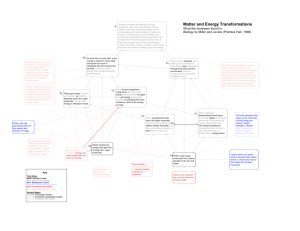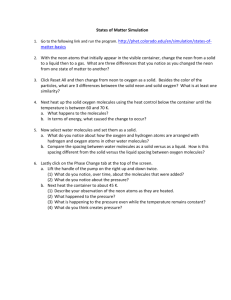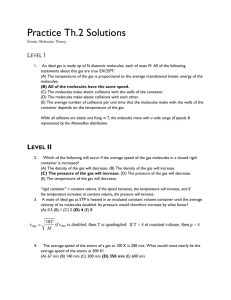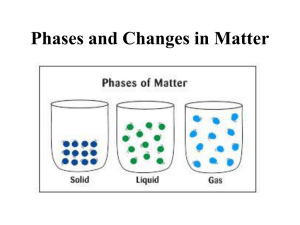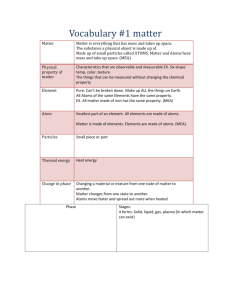Atoms and molecules are in constant motion
advertisement
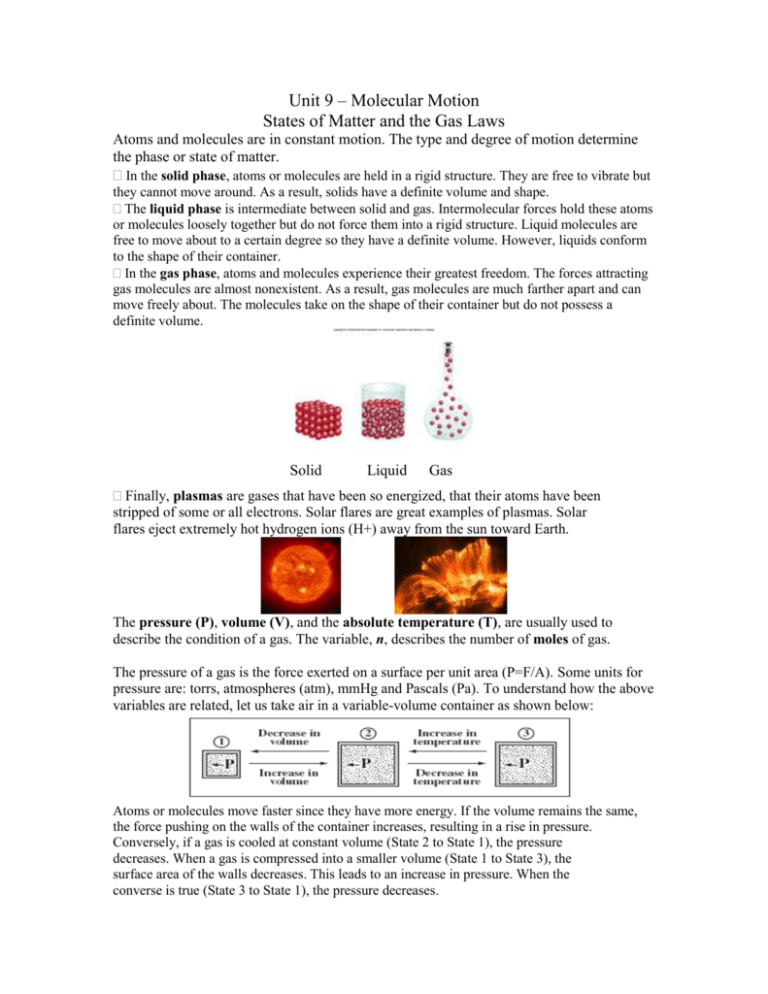
Unit 9 – Molecular Motion States of Matter and the Gas Laws Atoms and molecules are in constant motion. The type and degree of motion determine the phase or state of matter. In the solid phase, atoms or molecules are held in a rigid structure. They are free to vibrate but they cannot move around. As a result, solids have a definite volume and shape. The liquid phase is intermediate between solid and gas. Intermolecular forces hold these atoms or molecules loosely together but do not force them into a rigid structure. Liquid molecules are free to move about to a certain degree so they have a definite volume. However, liquids conform to the shape of their container. In the gas phase, atoms and molecules experience their greatest freedom. The forces attracting gas molecules are almost nonexistent. As a result, gas molecules are much farther apart and can move freely about. The molecules take on the shape of their container but do not possess a definite volume. Solid Liquid Gas Finally, plasmas are gases that have been so energized, that their atoms have been stripped of some or all electrons. Solar flares are great examples of plasmas. Solar flares eject extremely hot hydrogen ions (H+) away from the sun toward Earth. The pressure (P), volume (V), and the absolute temperature (T), are usually used to describe the condition of a gas. The variable, n, describes the number of moles of gas. The pressure of a gas is the force exerted on a surface per unit area (P=F/A). Some units for pressure are: torrs, atmospheres (atm), mmHg and Pascals (Pa). To understand how the above variables are related, let us take air in a variable-volume container as shown below: Atoms or molecules move faster since they have more energy. If the volume remains the same, the force pushing on the walls of the container increases, resulting in a rise in pressure. Conversely, if a gas is cooled at constant volume (State 2 to State 1), the pressure decreases. When a gas is compressed into a smaller volume (State 1 to State 3), the surface area of the walls decreases. This leads to an increase in pressure. When the converse is true (State 3 to State 1), the pressure decreases. Chemists have summarized these relations mathematically with the following laws: These laws are useful when trying to describe the properties of a gas under changing conditions. Charles's law, discovered by Jacques Charles, states that the volume of a quantity of gas, held at constant pressure, varies directly with the Kelvin temperature. Gases expand as they are heated and they contract when they are cooled. In other words, as the temperature of a sample of gas at constant pressure increases, the volume increases. As the temperature goes down, the volume decreases as well. The mathematical expression for Charles's law is shown below: V1/T1 = V2/T2 Where V = Volume and T = Temperature (in Kelvin) When you squeeze a balloon, you might notice that the harder you push, the harder it seems to push back. When you lie back on an inflatable mattress, or pool float, it compresses up to a point and then seems to stop. This is because as you decrease the volume of a confined gas, the pressure that it exerts increases. This relationship, called Boyle's Law, is summarized by the statement: The volume of a sample of gas is inversely proportional to its pressure, if temperature remains constant. The formula that can be used to calculate the affects of pressure changes on the volume of a gas at constant temperature is shown below: P1V1 = P2V2 Where P = Pressure and V =Volume Questions: What type of relationship is shown by the following graph? Answer: The volume is inversely proportional to pressure, thus the volume decreases with an increase in pressure. This relationship is expressed in Boyle’s Law.


